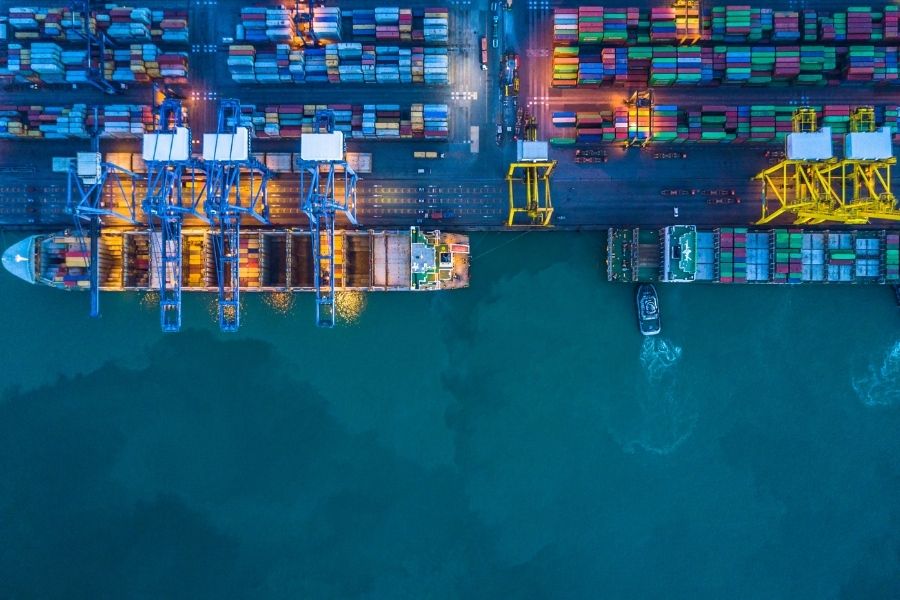Container shortages: How long will the quagmire last?
Container shortages have begun to have a significant impact on export shipments, besides enhancing volatility and causing unprecedented delays. Based on primary inputs from industry on the India-US trade route and academia, this blog explores the genesis, intensity and expected duration of the crisis and how India can avoid such a situation in future.

Container freight spot rates of all carriers have hit new records, as Asia-Europe route fares continue to surge. The rates are currently approaching US$ 9,000 per Twenty Foot Equivalent Unit (TEU), with further rises expected this month. Industry is wary of the situation as unfrequented container and shipping rates surge to a new high due to clogging at the major US ports, thereby disrupting the supply chain.
In its statement, the Trade Promotion Council of India said, “Data from ITC Trade Map shows that exports to US from India have grown by more than 20% compared to the 2019 in the first quarter of 2021 (April- June period). A change in trend is being observed with respect to exports. Companies are now more focused on proximate markets, where container turnaround times are shorter and freight costs are affordable, compared to long haul distances like Europe and US. If this trend continues, India might see a decline in the exports in coming months, as these are major markets of exports.”
Speaking on the surge, Sandip Patel of SLT Food Inc, and a US-based TPCI member said, “During pre-COVID, costs for India to North America were, on average, at US$ 1,800 per 20 feet container. This is now touching a high of US$ 6,000 per 20 feet container.” Comparing this to previous months, container trading data reveals that during the first trimester of 2021, the average prices for 20 feet containers across Europe rose by 57%. A surge in demand along with unexpected high volumes and pandemic-related restrictions were the main difficulties that lead to this problem, he added.
The US West Coast (USWC) is the worst hit, witnessing record breaking import volume, labour shortages and massive yard congestion. It is now experiencing severe delays and long dwell times. The vessel wait times being experienced are as below:
- Los Angeles/Long Beach: 10-18 days
- Seattle: 4-6 days’ vessel
- Oakland: 18-22 days is the vessel wait time.
- New York and New Jersey: 3-4 days
- Savannah & Norfolk: 2-3 days
While the US East Coast is witnessing an uptick in demand for imports, USEC terminals are experiencing heavy congestion and longer than usual dwell times due to a lack of available truckers and limited yard space. The industry is suffering further due to higher than average delay by container companies themselves, which has gone up by 160% to 3.9 days.
Shrikant Devhitka, Export Sales Director at Savion Ceramic (Q-BO) said, “The ocean freight cost has also kept on increasing after opening of the market. The rate from Mundra port in Gujarat to the US, which was between US$ 2,000 to 2,200 six months ago is today US$ 10,000 to 11,000. Our orders are getting diverted to Turkey and Spain, as they are closer destinations to the export market.’
YVR Sudhir, General Manager, Sales & Marketing. Frumar Agri Foods (P) Ltd, added, “Freight costs from Mumbai Nhava Sheva to Long Beach were at US$ 5,500/40 ft container in January 2021, which presently is at US$ 11,500. From Mumbai Nhava Sheva to New York, the cost has increased from US$ 4,000 for a 40’ container in Jan 2021 to US$ 8,500 presently.” The value of food products is low and can vary between US$ 10,000 to US$ 40,000 for a full container, depending on the product. For products like South Indian rice, the container FOB will be US$ 12,500 to US$ 14,000 and as such, the freight cost component of the product will be almost 80%,” he added.
As on 16th July 2021, China Container Freight Index (CCFI) increased by 2.7% in comparison to previous week. Drewry World Container Index (WCI) equalled US$ 8883 per 40 feet container, increasing by 339% in comparison to previous year.
Industry is worried that if this situation persists, there can be a 5% to 8% increase in the cost of goods from India. This will have an impact on exports too, due to equipment shortages or shipments will be postponed due to very high ocean rates. Demand for Indian products may slow down due to high costs.
The Shanghai Containerised Freight Index rose by 1.8% and the Drewrys World Container Index by 2% during the last week of May, as a decline in transpacific rates to the US west coast mitigated rises elsewhere; standing thus at nearly 300% above where it was during this same period in the past year. In the US, one of the biggest hurdles is re-structuring terminals to handle the influx of larger import vessels and the continuance of empty container prioritization.
Further Sandip Patel observed, “The problem started when global economies started entering lockdown during the first half of 2020, while China was recovering from it. The entire world bought medical protective equipment from China, but once those containers arrived and were unloaded in US or European ports, and due to the lockdowns that those countries were experiencing, there was not enough merchandise produced that allowed those containers to be filled and shipped out. Consequently, empty containers started stacking up in places where they were not needed, and they did not make it back to places they were actually required.”
Regarding the reasons for this quagmire, Dr Deepankar Sinha, Professor, IIFT, opined during a webinar on Shipping Freight Rate crisis organised by the Trade Promotion Council of India, “In the recent few months, we saw that there has been a sharp increase in export in one month, then a sharp decline and once again, an increase. The reason is, I believe, now the waiting time for a 40 feet container is around 40 to 45 days. So, the moment you put in the requisition for the container today, your exports, as on date, will actually happen next to next month and then follow this cycle.”
He added that the rise in exports is because countries that are recovering are willing to spend, like the US and Europe. But there has not been any opportunity for them to spend in the service sector like fine dining and travel. So all their expenses are getting diverted to goods. The impact differs across categories.
For daily essential goods, since the supply chain is disrupted, people have the tendency to overstock. As a result, inventories are piling up. All families of goods are moving from China to the US as one of the precautions and rightly so. So, containers out there are going to China, and out of every four containers that China is taking, three of them are empty. So, all empty containers are again being rushed to China. This creates a paucity for countries like India, which obviously will raise the costs. But for price elastic goods, which are sensitive to price rise, buyers are not expected to be so welcoming. Similarly, income elastic goods are also likely to fail because the overall economic recovery is not happening. But once the criris is controlled, Dr Sinha is positive that container access will improve, spends on services will increase and prices will come down.
However, it is important that India takes lessons from the current crisis, and look at ways in which container availability does not become a dampener for India’s exporters in the future. Some of the suggestions in this regard from industry and academia are as below:
- Diversifying into container manufacturing, and in the immediate term, this could be done by inviting foreign direct investment in this area.
- Enable faster clearance of containers, especially authorized economic operators for trade.
- Think of alternative routes and transshipment ports with less congestion and faster transit time. A strong & dedicated east-south railway network will lead to huge cost savings.
- India needs a very strong communication channel and it should also be interconnected with the world bodies wherein they discuss not only the problems and issues, but about maintain the transparency of shipping prices, or availability of containers.
- India should have tie ups with the World Customs Organization, International Chamber of Commerce, the International Maritime Organization and there has to be an efficient grievance redressal system.
- Accreditation of freight forwarders and shipping service providers needs to be properly relooked at, so that they provide professional services.













Hi, Thank you for sharing the informative information. I am impressed by the details that you have on this website.
<a href=http://abseacontainer.com/products/container-manufacturer.html>Container Manufacturers in Delhi</a>